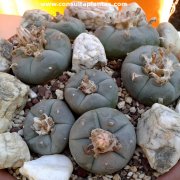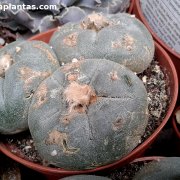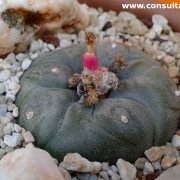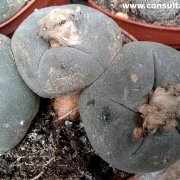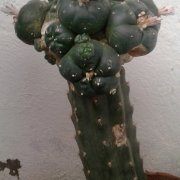Care of the catus Lophophora williamsii or Peyote |
|
The genus Lophophora, family Cactaceae, includes 2 species of small cactus native to northern Mexico: Lophophora williamsii and Lophophora diffusa. Common name: Peyote. They are small cacti with a flattened globular body that reach 5 cm (1.96") in height but form colonies. They are bluish-green or reddish-green (if they get a lot of sun) and have broad, flat ribs with areoles without spines but with trichomes. The flowers appear at the apex of the plant and can be white, pink or yellowish. They bloom in spring and summer; take years to bloom. This very slow growing and easy to grow cactus is used in deep pots because the roots are napiform. It's also used on rockeries in frost-free regions. It contains mescaline (hallucinogenic alkaloid) and is used in indigenous religious rituals. Lophophora williamsii need full sun exposure and high temperatures. In winter the temperature should be above 3 ºC (37.4 ºF). The soil can be a mixture, in equal parts, of leaf mulch, coarse sand, and brown peat. The transplant is done in early spring; do not water when transplanting, wait a few days. Peyote is extremely resistant to drought. It needs less water than other cacti. Do not water from mid-fall to early spring. Lophophora williamsii does not need fertilizers or pruning. Peyote is a plant resistant to pests but sensitive to excess humidity. Lophophora williamsii propagates from seeds sown in spring (they can be obtained from cylindrical fruits) or by separating suckers. |
Images of the cactus Lophophora williamsii or Peyote |
Find plants
Lophophora williamsii or Peyote | Care and Growing
© 2025 FavThemes
